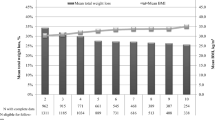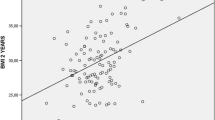Abstract
Background
In bariatric surgery, ideal body weight (IBW) is used to calculate excess body weight (EBW) and percent excess weight lost (%EWL). Bariatric literature typically uses the midpoint of the medium frame from older Metropolitan Life Insurance (MetLife) tables to estimate IBW. This is neither universal nor always clinically accurate.
Objective
The objective of this study was to determine the accuracy of standard IBW formulas compared to MetLife data.
Methods
Weight loss data from 200 bariatric surgical patients between 2009 and 2011 was used to assess the accuracy of IBW formulas. IBWs assigned from the midpoint of the medium frame and reassigned using different gender targets were compared to standard formulas and a new formula to assess the accuracy of all formulas to both targets.
Results
Using standard MetLife data, the mean IBW was 136 lb, the mean EBW was 153.6 lb, and the mean %EWL was 43.8 %. Using the new target baseline, the mean IBW was 137.1 lb, the mean EBW was 152.6 lb, and the mean %EWL was 44 %. Deitel and Greenstein’s formula was accurate to 0.3 % of EBW using the standard method, while our new formula was accurate to 0.03 % of EBW.
Conclusions
Deitel and Greenstein’s formula is most accurate using standard target IBW. The most accurate is our formula using the new MetLife target IBW.
Similar content being viewed by others
References
Cole TJ. Secular trends in growth. Proceedings of the Nutrition Society. 2000;59:317–324
Ogden CL, Carroll MD, Kit BK, Flegal KM. Prevalence of Obesity in the United States, 2009–2010. NCHS data brief, no 82. Hyattsville, MD: National Center for Health Statistics. 2012.
Deitel M, Greenstein RJ. Recommendations for Reporting Weight Loss. Obesity Surgery. 2003;13:159–160.
Metropolitan Life Insurance Company. Ideal Weights for Women. Statistical Bulletin. 1942;23:6–8.
Metropolitan Life Insurance Company. Ideal Weights for Men. Statistical Bulletin. 1943;24:6–8.
Metropolitan Life Insurance Company. 1983 Metropolitan Height and Weight Tables. Statistical Bulletin. 1983;64:1–9
Shah B, Sucher K, Hollenbeck CB. Comparison of Ideal Body Weight Equations and Published Height-Weight Tables With Body Mass Index Tables for Healthy Adults in the United States. Nutrition in Clinical Practice. 2006;21:312–319.
Halls.md Health calculators and charts. Ideal Body Weight Formulas by Broca and Devine. Available at: http://www.halls.md/ideal-weight/devine.htm. Accessibility verified December 16, 2013.
Mémoires d’anthropologie. Paris, 1871/1877
Hamwi GJ. Therapy: changing dietary concepts. In: Diabetes Mellitus: Diagnosis and Treatment (vol. 1). Danowski TS ed. American Diabetes Association. New York. 1964, 73–8.
Miller MA. A Calculated Method for Determination of IBW. Nutr Support Serv. 1985;5:31–33.
Devine BJ. Gentamicin Therapy. Drug Intell Clin Pharm. 1974;8:650–655.
Metropolitan Life Insurance Company. New Weight Standards for Men and Women. Statistical Bulletin. 1959;40:1–4.
Robinson JD, Lupkiewicz SM, Palenik L, Lopez LM, Ariet M, Determination of ideal body weight for drug dosage calculations. Am J Hosp Parm. 1983;40:1016–1019.
Miller DR, Carlson JD, Loyd BJ et al. Determining Ideal Body Weight. Am J Hosp Pharm. 1983;40:1622.
Lemmens HJM, Brodsky JB, Bernstein DP. Estimating Ideal Body Weight – A New Formula. Obesity Surgery. 2005;1082–1083
Baltasar A, Perez N, Serra C, Bou R, Begochea M, Borras F. Weight Loss Reporting: Predicted Body Mass Index After Bariatric Surgery. Obesity Surgery. 2011;21(3):367–372
Ogden CL, Fryar CD, Carroll MD, Flegal KM. Mean body weight, height, and body mass index, United States 1960–2002. Advance data from vital and health statistics; no. 347. Hyattsville, MD: National Center for Health Statistics. 2004.
Conflict of Interest
All authors have no financial disclosures or conflicts of interest to report. This manuscript has been seen and approved by all authors and the material is previously unpublished.
Author information
Authors and Affiliations
Corresponding author
Rights and permissions
About this article
Cite this article
Kammerer, M.R., Porter, M.M., Beekley, A.C. et al. Ideal Body Weight Calculation in the Bariatric Surgical Population. J Gastrointest Surg 19, 1758–1762 (2015). https://doi.org/10.1007/s11605-015-2910-4
Received:
Accepted:
Published:
Issue Date:
DOI: https://doi.org/10.1007/s11605-015-2910-4




